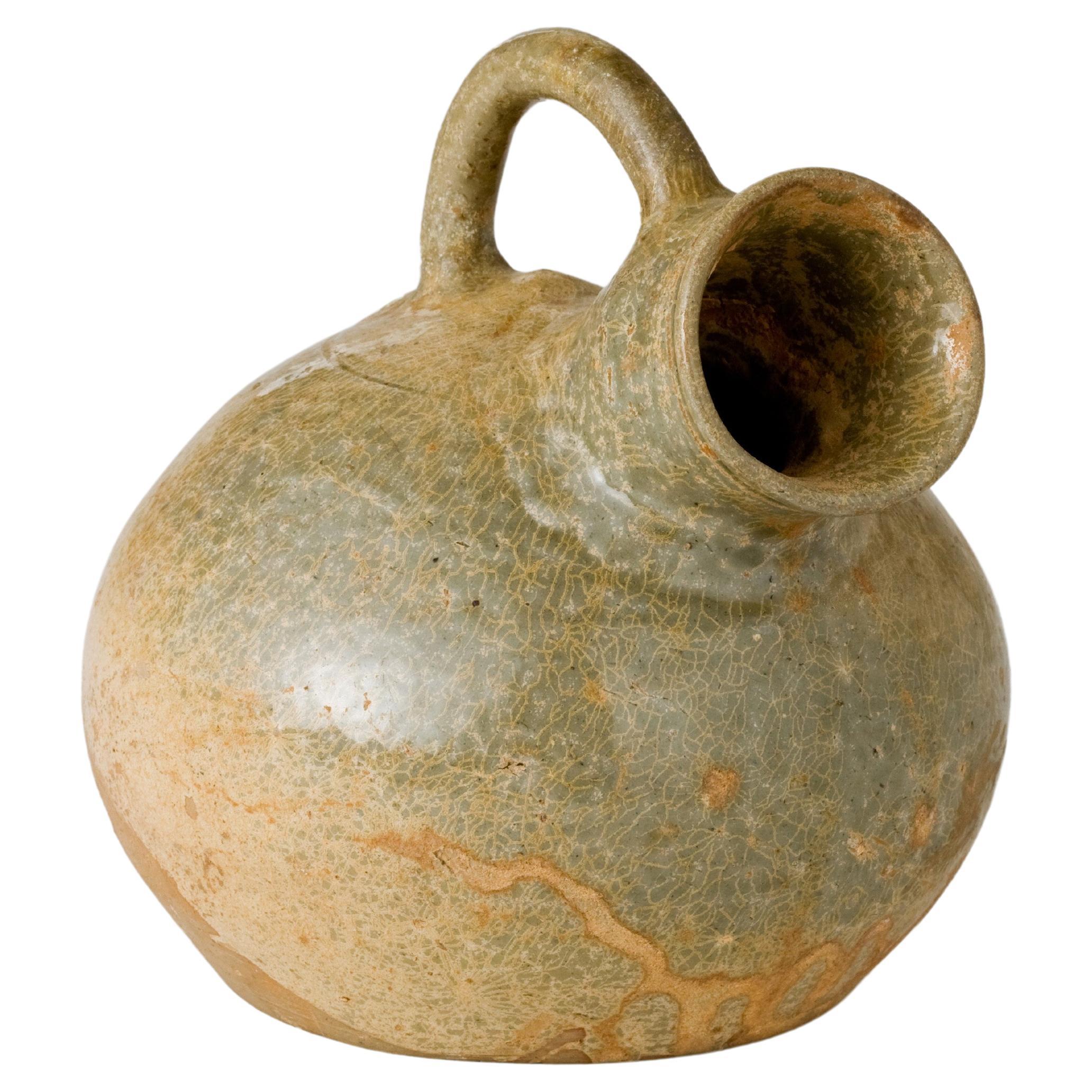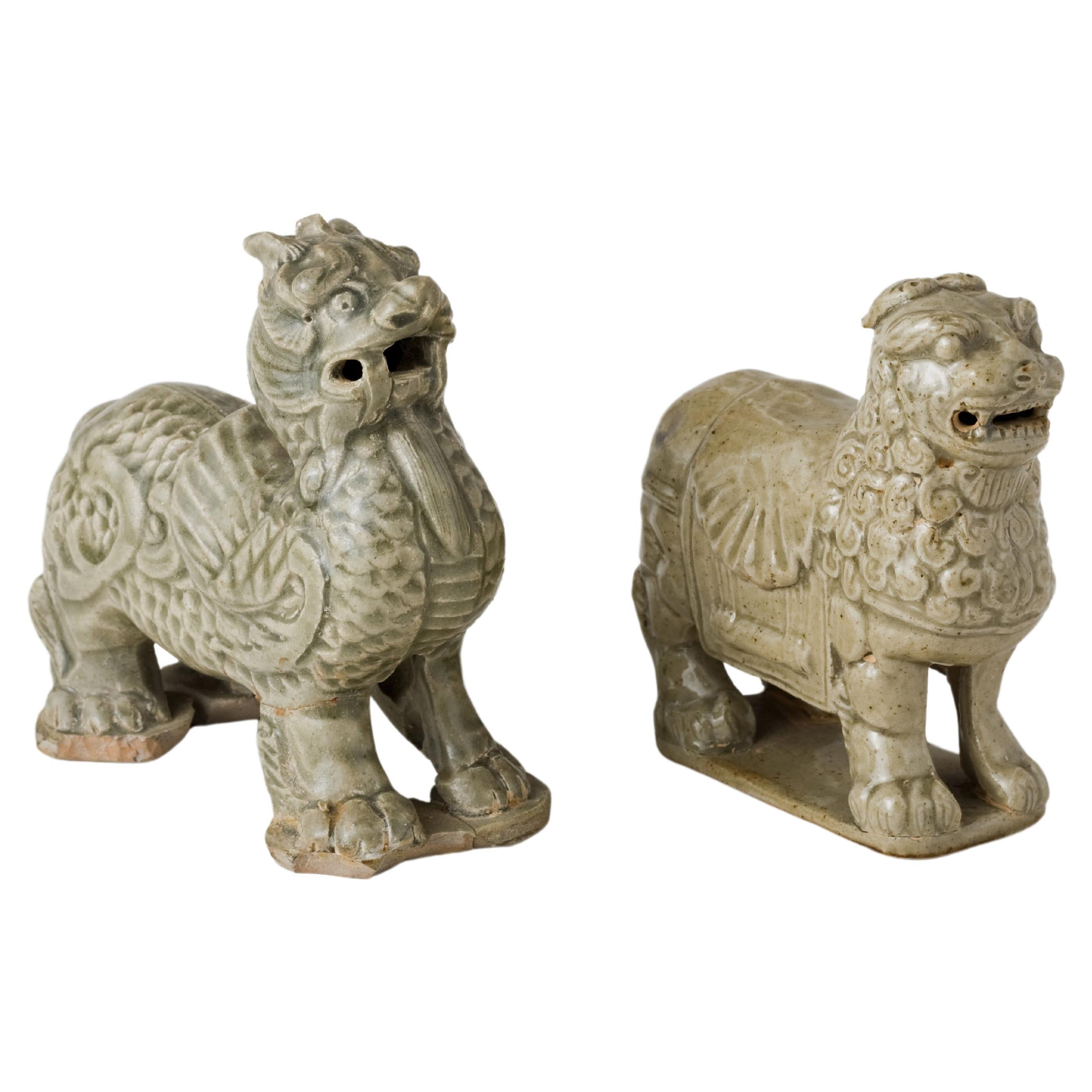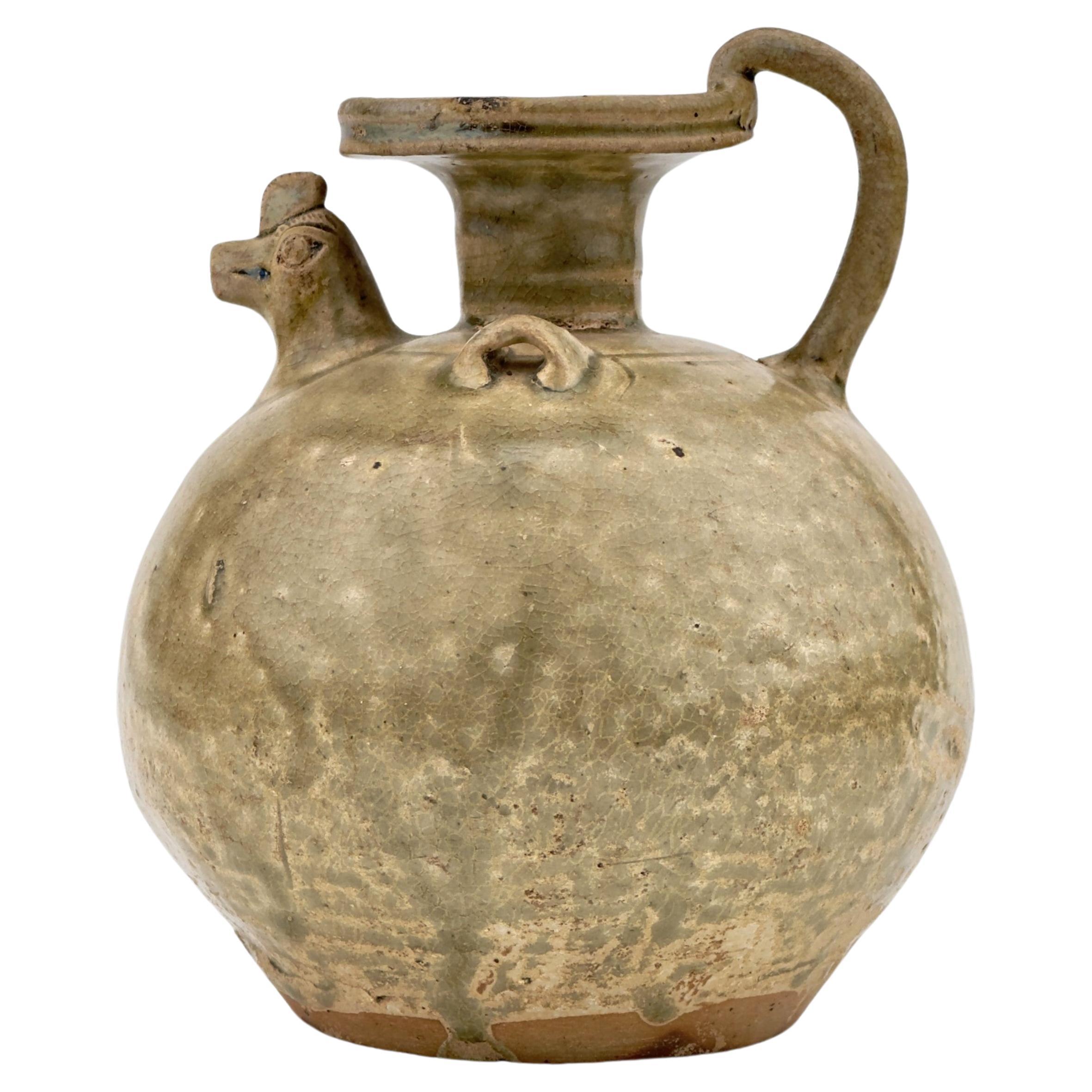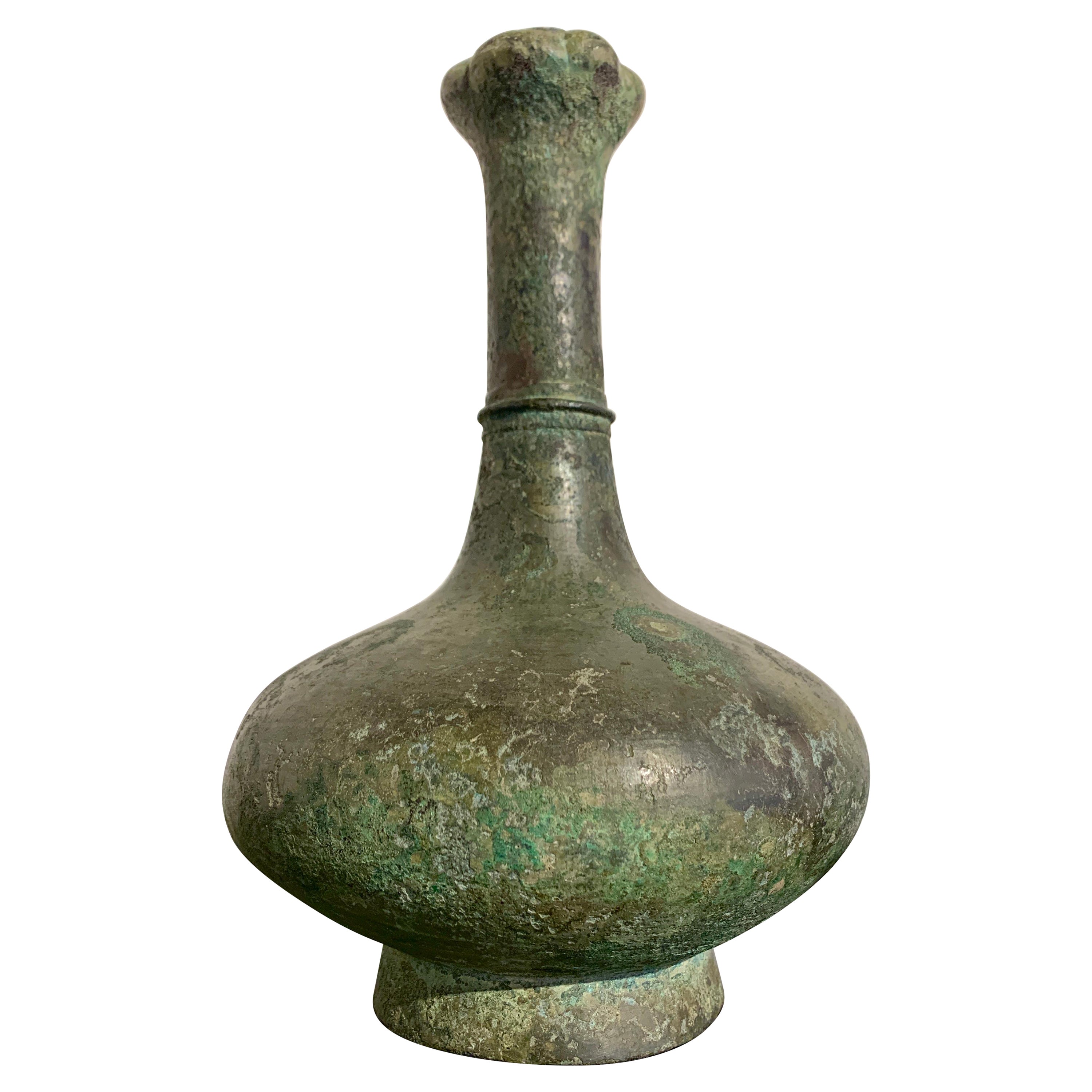Items Similar to A Rare 'Yue' Celadon Glazed Octagonal Vase, Western Jin Dynasty (266 - 316 AD)
Want more images or videos?
Request additional images or videos from the seller
1 of 17
A Rare 'Yue' Celadon Glazed Octagonal Vase, Western Jin Dynasty (266 - 316 AD)
About the Item
Finely potted with incurved facetted sides divided by raised ribs and set with two short lugs to the shoulder, the body rising to a short octagonal neck, the domed cover of conforming section, surrounded by an upturned rim and surmounted by a bud finial, applied overall with a celadon glaze of the period.
A related vase of this rare and charming form, in the Zhenjiang Museum, Zhenjiang, is illustrated in the Complete Collection of Chinese Ceramics. Song, vol. 8, Shanghai, 1999, pl. 52. Vases of related octagonal shape were produced at the Ding kilns, in Hebei province, and the qingbai kilns in Jiangxi province; see a Ding vase in the Palace Museum, Beijing, illustrated in Selection of Ding Ware. The Palace Museum’s Collection and Archaeological Excavation, Beijing, 2002, pl. 37; and a qingbai example, from the Meiyintang collection, illustrated in Regina Krahl, Chinese Ceramics from the Meiyintang Collection, vol. 3 (II), London, 2006, pl. 1590; and another carved with a floral scroll, included in the exhibition Song Ceramics from the Kwan Collection, Hong Kong Museum of Art, Hong Kong, 1994, cat. no. 105.
Period : Western Jin Dynasty (266 - 316 AD)
Type : Octagonal Vase
Medium : Yue celadon(Stoneware)
Provenance : The piece was acquired in Hong Kong in the year 1999.
Reference :
1) Sotheby's Hongkong 02 June 2016 - Chinese Art Lot 601
(Price : 1,062,500 HKD / Type : Closely related)
2) Christies Hongkong 30 May 2023 - Important Chinese Ceramics and Works of Art Lot 3318
(Price : 189,000 HKD / Type : Related)
3) Sotheby's London 16 May 2018 - Important Chinese Art Lot 68
(Price: 50,000 GBP / Type : Related)
* Yue Celadon
Yue celadon, also known as Yue ware, is a type of Chinese pottery with a celadon glaze, originating from the eastern Han dynasty in the Zhejiang province. The name 'Yue' comes from the Yue kilns which were among the earliest to develop the celadon technique. Yue ware is known for its jade-like glaze, which can range in color from bluish-green to olive green.
Yue celadon was highly regarded during its time and was the first Chinese ware to be imported in large quantities to the Middle East and Africa, significantly influencing the development of ceramics in those regions. The production of Yue ware continued to evolve, and during the Tang dynasty, it became more refined with more complex shapes and decorations. By the time of the Song dynasty, it had greatly influenced other kiln traditions, leading to the development of the classic longquan celadon, which became one of China’s most famous ceramic products.
Yue celadon traditionally embodies elements of auspiciousness and good fortune in Chinese culture. The jade-like celadon glaze is often associated with longevity and health. Various motifs and shapes inscribed on the pottery frequently symbolize luck and prosperity. For example, lotus patterns may represent purity and immortality, while animal figures like the lion symbolizes power, courage, and strength. Lions are considered protectors that ward off evil spirits and bring forth good luck. Furthermore, Yue celadon wares were commonly used as tomb offerings in ancient China, believed to bring fortune and well-being to the deceased in the afterlife.
About the Seller
New to 1stDibs
Joined in the past six months.
4.5
Vetted Seller
These experienced sellers undergo a comprehensive evaluation by our team of in-house experts.
Established in 1999
1stDibs seller since 2023
Typical response time: 1 hour
- ShippingRetrieving quote...Ships From: seoul, Korea South
- Return PolicyA return for this item may be initiated within 10 days of delivery.
More From This SellerView All
- Rare Yue Celadon-Glazed Vessel, Jin dynasty (265-420)Located in seoul, KRA Yue celadon vessel from the Jin Dynasty period, notable for its characteristic greenish-glazed pottery which was prominent during this time. The vessel features a globular body wit...Category
Antique 15th Century and Earlier Chinese Han Antiquities
MaterialsStoneware
- Rare Boshan Incense Burner Yue Celadon, Jin dynastyLocated in seoul, KRThe Boshan incense burner is particularly notable among Han dynasty incense burners for its unique shape. Designed to resemble a mountain or even a mythical mountain, it is characterized by its pointed peaks that rise upwards. These peaks often function as vents for the smoke, creating an effect reminiscent of a volcanic eruption. The body of the incense burner is typically round, with multiple small peaks surrounding a central, larger peak. The material used is mainly ceramic, although there are instances where they were made of bronze. It is presumed that this incense burner was used for religious or ceremonial purposes during its time. The colors of these burners are usually in shades of pale green or greyish brown, with the application of glaze to achieve a variety of colors on occasion. Such incense burners are often found in tombs or ritual sites, and their purpose was to burn incense for purification of space or to produce pleasant aromas. The Boshan incense burner also represents a significant cultural heritage, showcasing the craftsmanship and artistic values of the period. Today, it is considered a quintessential example of ancient Chinese art. Period : Han-Jin Dynasty Type : Incense Burner Medium : Yue celadon...Category
Antique 15th Century and Earlier Chinese Han Antiquities
MaterialsStoneware
- A Yue Celadon-Glazed Figural Vessel, Western Jin dynasty (265-420)Located in seoul, KRThis vessel is well-modeled as a recumbent winged lion with detailed decorative elements. It features a grimacing face with large protruberant eyes under heavy brows and a gaping mouth, which forms a large aperture. The piece has a tail that arches to form a loop handle, and the wings are incised on the sides. The whole piece is finished with a thin olive-green glaze. This kind of figural vessel dates back to at least the Western Han dynasty, with the design fully developed in the Yue kilns of Zhejiang province during the 3rd and 4th centuries. Such zoomorphic forms became popular among the literati and were transformed into various functional objects like wine ewers and water pots. For a similar example see Regina Krahl, Yueguetang, A Collection of Chinese Ceramics in Berlin, Berlin, 2000, p. 68, no. 46 where the author cites another similar example excavated from a tomb at Fenghuangshan, Shaoxing, Zhejiamg province and dated to 313 AD. A very similar vessel from the Zhejiang Provincial Museum was exhibited in Greenwares from Zhejiang, Hong Kong, 1993, cat. no.18. Other illustrated examples in museum collections include The Nanjing Museum, Celadons of the Six Dynasties from Jiangxu, Beijing, pl. 50; the Shanghai Museum, Complete Series on Chinese Art: Arts and Crafts Section: 1. Ceramics, vol. 1, Shanghai, 1988, pl. 193; The Metropolitan Museum of Art, Suzanne G. Valenstein, A Handbook of Chinese Ceramics, New York, 1989, p. 52, no. 43. Period : Western Jin Dynasty (266 - 316 AD) Type : Figural vessel Medium : Yue celadon(Stoneware) Diameter : 19cm Provenance : The piece was acquired in Hong Kong in the year 1999. Reference : 1) Sotheby's New York 17 March 2015 - Chinese Art Through The Eye Of Sakamoto Gorō – Ceramics Lot 33 (Price Range : 15,000 USD-20,000 USD / Type : Highly related) 2) Sotheby's London 16 May 2018 - Important Chinese Art Lot 68 (Price : 50,000 GBP / Type : Closely related) * Yue Celaodn Yue celadon, also known as Yue ware, is a type of Chinese pottery with a celadon glaze, originating from the eastern Han dynasty in the Zhejiang province. The name 'Yue' comes from the Yue kilns which were among the earliest to develop the celadon technique. Yue ware is known for its jade-like glaze, which can range in color from bluish-green to olive green. Yue celadon was highly regarded during its time and was the first Chinese ware...Category
Antique 15th Century and Earlier Chinese Chinese Export Antiquities
MaterialsCeladon
- Rare Yue Celadon-Glazed Two Haitai Statues, Western Jin dynasty (265-420)Located in seoul, KR* Set item(Two statues) The statue on the left seems to be a mythical beast standing in a poised and alert stance, with its mouth open as if roaring or breathing fire. Its body is covered in detailed carvings that resemble scales and feathers, indicative of the high level of craftsmanship during the Jin Dynasty. The creature’s presence is both regal and intimidating, suggesting it might have been believed to possess protective properties. The statue on the right presents a more stoic and solid stance, with a broad chest and a upright head. Its facial expression is stern, with deep-carved eyes and an open mouth that reveals its teeth, adding to its majestic and formidable appearance. The mane and other body features are intricately detailed, suggesting a high level of artistic skill in its creation. Period : Western Jin Dynasty (266 - 316 AD) Type : Haitai Statue Medium : Yue celadon...Category
Antique 15th Century and Earlier Chinese Chinese Export Antiquities
MaterialsCeladon
- Rare Yue Celadon Chicken-Head Ewer, Jin-Southern DynastyLocated in seoul, KRChicken-head ewers are among the most distinct and emblematic pottery pieces from the dynamic yet innovative era spanning from the Han (206 BC - AD 220) to the Tang (618~907) dynasti...Category
Antique 15th Century and Earlier Chinese Han Antiquities
MaterialsStoneware, Celadon
- Hu Shape Green-Glazed Vase, Han Dynasty(206 BC - 220 AD)Located in seoul, KRA 'Hu' is a type of large jar or pot that was commonly used in China for storage purposes, including holding liquids or dry goods like grains. This particular shape of pottery usually features a wide body and a narrow opening, and sometimes comes with a lid. The 'Hu' could also be more elongated with a slender neck, designed for easy pouring of liquids. The rainbow-like colors on this green-glazed surface come from changes that happen over hundreds of years while it's buried. This process is also known as "iridescence" and is often observed in ancient Chinese green pottery...Category
Antique 15th Century and Earlier Chinese Han Antiquities
MaterialsEarthenware
You May Also Like
- Chinese Western Han Dynasty Bronze Garlic Head Vase, 206 BC - 25 ADLocated in Austin, TXA rare and attractive Chinese bronze "garlic head" vase with an encrusted patina, Western Han Dynasty, 206 BC - 25 AD, China. Of classic form, the bronze vase is set on a short, s...Category
Antique 15th Century and Earlier Chinese Han Antiquities
MaterialsBronze
- A Large Han Dynasty (206BC-220AD) Glazed Hu VesselLocated in Chicago, ILThis is a fine example of a Han hu wine storage vessel, buried for the afterlife. The compressed globular body narrows sharply to a slender waisted neck, covered with a dark green le...Category
Antique 15th Century and Earlier Chinese Han Antiquities
MaterialsTerracotta
- China Ancient Stone Entertainer, Han Dynasty 200 ADLocated in South Burlington, VTChina an ancient limestone figure of an Entertainer replete with hands holding tambourines and a top a drum, -for the afterlife- , Han dynasty 206 BC...Category
Antique 15th Century and Earlier Chinese Han Sculptures and Carvings
MaterialsLimestone
- Elegant Han Dynasty Terracotta Warrior - China '206 BC - 220 AD'Located in San Pedro Garza Garcia, Nuevo LeonImpressive terracotta warrior representing a banner bearer gripping a wooden staff with his hands (dematerialized through the ages); his gaze is ser...Category
Antique 15th Century and Earlier Chinese Han Antiquities
MaterialsTerracotta
- Chinese Cocoon Jar, Burnished Gray Pottery, Western Han Dynasty, ChinaLocated in Austin, TXA classic Chinese Han Dynasty "cocoon jar" of high fired burnished gray pottery, Western Han Dynasty (206 BC - 9 AD), China. The jar of typical form, w...Category
Antique 15th Century and Earlier Chinese Han Antiquities
MaterialsPottery
- Han Dynasty Green Glazed Covered Storage JarLocated in Austin, TXA wonderful Han Dyansty (206 BC-200 AD) storage vessel. The circular body set upon three legs and fitted with a lid. The entirety covered in heavy leaded green glaze, imitating bronz...Category
Antique 15th Century and Earlier Chinese Han Antiquities
MaterialsPottery
Recently Viewed
View AllMore Ways To Browse
African Ceramic Pottery
Song Ding
Chinese Glazed Cat
Lotus Ware
Antique Chait
Antiques Period Llc
Modern Architectural Chair
Marble Base Italy
Italian Plates Made In Italy
Bar Stool
Modern Bubbles
Wire Bulb Chandelier
Midcentury Modern Table Chairs
Light On Chain
Italian Lighting For Ceiling
High Pile
Leather Down
Mid 19th Century American





